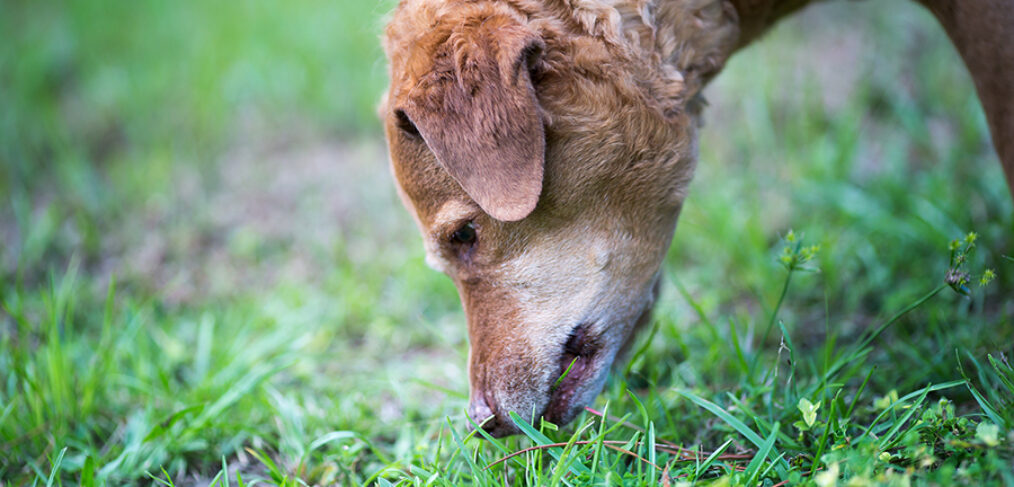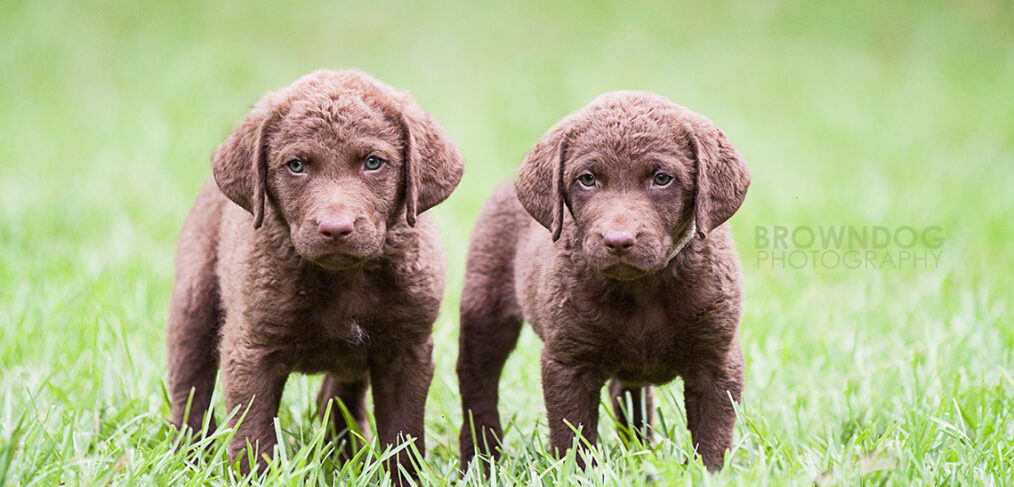
Chesapeake Bay Retriever Puppy in X-Pen
Daily I am contacted by people interested in a Chesapeake puppy. Some of these inquiries have had Chessies before, others have not. Most who inquire about a puppy simply ask for the price and very, very few ask about temperament or the health of the dogs. Even less ask about me – my policies, my thoughts on breeding practices, how my dogs live, what do I do with my dogs (if anything). As such, I have found for many inquiring about a dog price is the determining factor. When asked about my prices, some are surprised, others not so much. However, in the end it all boils down to options.
The price for a well-bred Chesapeake puppy typically ranges between $850 and $1,500 with $1,000-$1,200 being the average. Yes, you can find Chessie puppies cheaper out there on the Internet. And yes, you can even find them more expensive. However, buyers beware. Not all breeders, not all litters, and not all circumstances in which litters are raised and dogs kept are the same. In the end, it all comes down to options and what one feels most comfortable with.
Here are some ‘general’ options. Some breeders may overlap scenarios (for example some breeders in B might belong in Option A while some might belong in Option C. They key is to use this is a guideline and then do your research. If you are going to spend your hard earned money on a puppy – be informed and educated on your options and what makes them different from one another.
Options: BREEDERS
Not all breeders are the same and it can be difficult to weed through some of the Internet marketing ploys, gimmicks and fancy talk. Some breeders are sincere; others just want your money. As a buyer, think of your purchase as an investment. As an investment it is your responsibility to be an educated purchaser.
Before I go into the different breeder options, I want to state that there are several health issues in the Chesapeake breed. We have elbow dysplasia, hip dysplasia, inheritable cataracts, degenerative myelopathy (DM), EIC (exercised induced collapse), progressive retinal atrophy (PRA), seizures, thyroidal issues, autoimmune issues – oh the list goes on. Some of these items can be tested for. This allows breeders to make decisions as to which dogs they breed and why. Sometimes the best breedings on paper can wind up with issues. However, I am a firm believer in trying to stack odds in my favor, when possible.
Option A
Breeder A – $350-$500: this breeder does no health clearances on any of their dogs. They say they have ‘champions in the bloodlines’ or that their dogs are ‘full-blooded’ (I sure hope the dog is full of blood). Most of these puppies are produced with no reason other than to just have a litter to have a litter. Sometimes the parents are breed over and over again with no regards to how the dogs match up. They think having a litter is a great idea because a.) they think they can make money b) they have two dogs so why not breed them c) they think it’ll calm the female down — among other things. This breeder wants your money, gives you your dog, and you never hear from them again.
Option B
Breeder B – $750-$800: hips are certified. No other clearances. Breeding for same basic reasons as above only they justify the prices because hips are certified or because the dogs are ‘registered’ pure-breds.
Option C
Breeder C – $850 – $1,500: dogs have multiple health certifications including but not limited to DM, EIC, HIPS, CERF, PRA. Many times these breeders evaluate for temperament, work ability and structure. You will often see these dogs active in different dog venues such as showing, hunt tests, field trials just to name a few. Many of these breeders laugh and cry with you as you and your puppy grow together. Some become not only a ‘breeder’ of your dog but they also become good friends.
However, even within this price range there is good and there is bad. Some breeders pay attention to temperament, some do not. Some breeders provide lifetime follow-up/support for their puppies, some do not. Some over market, over inflate their dogs value/worth with sales ploys. Do your research.
Options: ADOPTION
There are a couple of options for adoption. My referral would be to work with a reputable rescue organization, such as Chesapeake Bay Retriever Relief & Rescue (www.cbrrescue.org). Rescue organizations typically house dogs in foster homes where they are evaluated with other dogs and people. They also provide basic health care to the dog ensuring that the dogs are up to date on shots, spayed/neutered, and heart worm negative (or treated) before going to their new home. With that said, however, many fine dogs have come directly from shelters as well.
Option D
Rescue – $150-$450: many wonderful dogs end up in rescue each year due to no fault of their own. By considering, and adopting, a slightly older dog, you give that dog a wonderful new start on life and that dog will give you the love/companionship you seek.
While there are many pro’s to adopting there is one thing to note – *most* of the time the history/background on dogs in rescue is unknown. These dogs come from a variety of backgrounds – shelter surrenders, owner surrenders, picked up as strays etc.. as such, many times we just don’t know their history.
Some people care about this. Some do not. Regardless, it is something to be aware of… This means that rescue will not know if your dog has PRA (or if the parents did). Rescue cannot tell you that his/her parents/grandparents had long lifespans of 10, 12, 15 years or whether the parents had DM. This means those nuances that your dog might do will often remain a mystery. And, that’s ok, for some.
Option E
Adopt from a Shelter. Many dogs are listed in shelters each day/week. Adoption fees vary from shelter to shelter. They can range from $50 up to $150. Adoption fees vary from shelter to shelter. They also may or may not include heart worm testing, spaying/neutering and vaccinations. Typically these dogs have not had any real evaluation. This means they might be bad with other dogs, they might’ve been surrendered to the shelter due to a bite history or due to food aggression, they might’ve been strays and nothing is known other than it’s a brown dog on the side of the road. When you adopt directly from a shelter you take on some potential risks that rescue helps offset by having dogs live in foster homes first.
Options: MISCELLANEOUS
Option F
Purchase an older dog from a breeder. Some breeders, at some point, offer slightly older dogs that either didn’t work out in a breeding program or was bred at one time and is now ‘retired.’ These dogs can sometimes make great companions and are often placed at a reduced cost. From a reputable breeder, the history, health, pedigree, etc.. are usually known.
Like I said, it boils down to options and what one feels most comfortable with.
I often tell people who are looking for a puppy – find someone, a breeder, you like. Get to know them. Get to know what they believe in. Get to know what their support is like. Are they there when you have questions? Are they there to help you if you have a training issue? Are they there when you have a concern? Once you find someone you trust, be put on their waiting list. Depending on the breeder, it might take a year for that puppy to come along but your time and efforts will be worth the wait in the long run.
Also, if you are buying a puppy, buy one from someone who does health clearances. The initial investment of a puppy is very small compared to the cost and care of the dog over its lifetime. While the best of breedings can sometime go awry, if you are paying $700, $800, a thousand dollars for a puppy – don’t you want to try and stack the odds in your favor?
Our puppy owners become an extended part of our family – dog family, but our family no less. While you can’t pick and choose your real family, you most certainly can pick your dog family. It all comes down to options.







